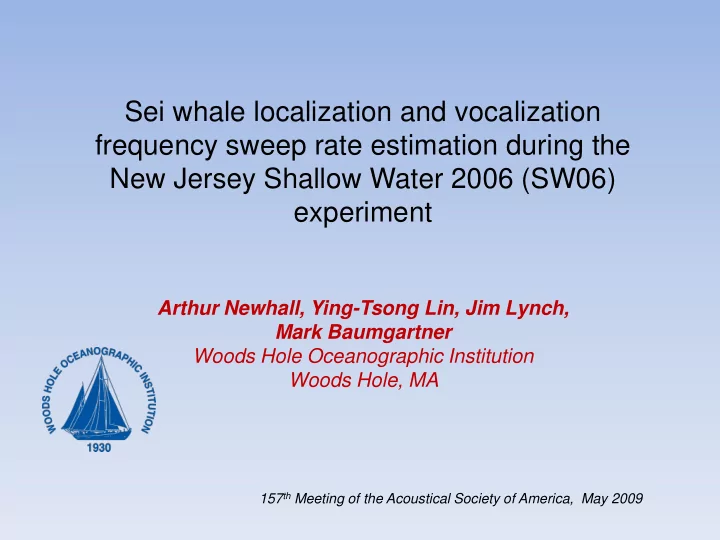

Sei whale localization and vocalization frequency sweep rate estimation during the New Jersey Shallow Water 2006 (SW06) experiment Arthur Newhall, Ying-Tsong Lin, Jim Lynch, Mark Baumgartner Woods Hole Oceanographic Institution Woods Hole, MA 157 th Meeting of the Acoustical Society of America, May 2009
Outline Sei Whale Sei whales and the SW06 experiment Sei whale vocalizations Our approach and results Conclusions
Sei Whales Relatively little is known about their vocalizations - Loud, long, low-frequency sounds - Frequency modulates from ~120 to ~40Hz in our receptions - Vocalizations often seen in pairs, sometimes triplets - 150+ recorded vocalizations in our data during 2 days (Sep 12,13) Most activity seen during early evening We will study these vocalizations more in depth - track, locate (range and depth) - recreate source signature (unknown) - identify individuals
Shallow Water 2006 (SW06) Experiment Mode propagation approach low frequency broadband shallow water SW06 area of study Vertical hydrophone line array Horizontal line array WHOI VLA/HLA WHOI VLA/HLA was our primary receiver. Deployed at 80 m water depth. Sampled at ~10 kHz Frequency band 10 Hz to 5000 Hz. Directly N-S orientation
Sei whale vocalizations and fin whale vocalizations 125 recorded vocalizations during Sep 12 -> 13 sei whale signal 2 sei whale signal 1 fin whale Identified sei whale signals 50 Hz bandwidth Original sound bandpass filtered Harmonics evident in many signals x2 and bandpass filtered Same whale or 2 (or 3) individuals?
Normal mode back propagation approach Beamform using horizontal line hydrophone array to find bearing Mode filter the received signal Back propagate to calculate range to source Reconstruct original source signal at range and find depth of source
Calculating bearing using horizontal line array data Beamformed on three sei whale signals Two are distinct individual whales The paired signal is from the same individual 1 2 The later single signal is from another Since array was slightly curved, we also beamformed in sections to verify L/R ambiguity. Sei whale signal 1 Sei whale signal 2
Normal mode back propagation approach Beamform using horizontal line hydrophone array to find bearing Mode filter the received signal Back propagation to calculate range of source Reconstruct original source signal at range and find depth
Acoustic normal mode filtering Mode filtering is performed using the vertical line array to resolve individual modal arrivals Simulation example of a sound pulse propagation in the mixed-layer waveguide model. (Source at 25m depth, fc = 50Hz, BW = 50Hz) Mode filter output
Mode filtering using vertical line array data Mode 1 Mode 2 Sei whale signal with mode 1 and mode 2 overlayed on signal from Channel 3 on Sept 13 Mode 3 M1 red M2 white Mode 3 is not seen on hydrophone #3 but appears on others. This is due to mode 3 having a null at this depth.
Normal mode back propagation approach Beamform using horizontal line hydrophone array to find bearing Mode filter the received signal Back propagation to calculate range of source Reconstruct original source signal at range and find depth
Low-frequency broadband source localization by back- propagating acoustic normal modes • We use modal dispersion to localize a sound source. • The first step is to implement a mode filter to obtain individual modal arrivals. Then, back propagate the modal arrivals with their own group speeds, which are derived from the waveguide parameters . The source range estimate is where the back- propagated modes line up with each other. received signal (simulation) back propagate back propagate modes for 5 km modes for 15 km
Range estimation for sei whale signal 1 Least square fit estimation Frequency tracking of original modal arrivals Frequency tracking of back propagated modes at estimated source localization. Sei whale signal 2 range estimation was at 800 m
Normal mode back propagation approach Beamform using horizontal line hydrophone array to find bearing Mode filter the received signal Back propagation to calculate range of source Reconstruct original source signal at range and find depth
Depth estimation and reconstruction of source signal We know direction and range Now reconstruct source signal of each mode for all possible depths. Depth estimate is chosen by finding the best (least squares) fit between the reconstructed modal source signals. Signal peaks and nulls are lined up.
Final reconstruction of the source signal at range and depth for signal 1 mode 1 red mode 2 blue mode 1 reconstruction mode 2 reconstruction
Summary of study Sei whale signal 1 (pair) Sei whale signal 2 93° East 109° West Bearing 5000 m 800 m Range 33.5 m or 73 m* 34 m or 66.5 m * Depth Frequency range of signal 100-30 Hz 120-35 Hz Original sweep rate 1.7 sec 1.07 sec from 100-40 Hz Reconstructed sweep rate 1.35 sec .87 sec from 100-40 Hz * Note: 2 possible depths here since they both are close to our depth- selection criteria.
Conclusions from this study Seiwhale vocalization reconstruction performed * Source signal rate Sweep rate is non-linear ~1 second, singles and pairs The 2 whales had different freq ranges Signal duration shortened from received signal due to acoustic normal mode dispersion * Good estimation of directionality * Range and depth estimates might have some uncertainty Need better environment (water column and bottom) information * Depth of all vocalizations are subsurface (below thermocline) * Using localization and frequency content, we can identify if signals are from same individual. * More to be done! We hope to be able to identify each individual in our data from its source signature. Count individuals, count numbers in groups, migratory speeds and direction…, We want to compare our results with other sei whale studies (ie pacific) .
Recommend
More recommend